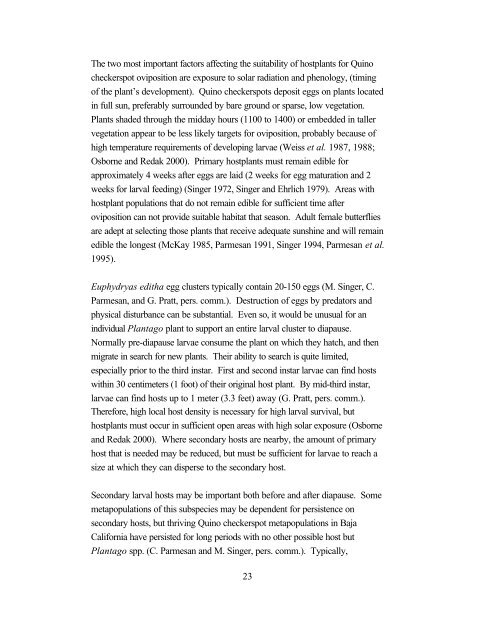Outline of Quino Recovery Plan - The Xerces Society
Outline of Quino Recovery Plan - The Xerces Society
Outline of Quino Recovery Plan - The Xerces Society
You also want an ePaper? Increase the reach of your titles
YUMPU automatically turns print PDFs into web optimized ePapers that Google loves.
<strong>The</strong> two most important factors affecting the suitability <strong>of</strong> hostplants for <strong>Quino</strong><br />
checkerspot oviposition are exposure to solar radiation and phenology, (timing<br />
<strong>of</strong> the plant’s development). <strong>Quino</strong> checkerspots deposit eggs on plants located<br />
in full sun, preferably surrounded by bare ground or sparse, low vegetation.<br />
<strong>Plan</strong>ts shaded through the midday hours (1100 to 1400) or embedded in taller<br />
vegetation appear to be less likely targets for oviposition, probably because <strong>of</strong><br />
high temperature requirements <strong>of</strong> developing larvae (Weiss et al. 1987, 1988;<br />
Osborne and Redak 2000). Primary hostplants must remain edible for<br />
approximately 4 weeks after eggs are laid (2 weeks for egg maturation and 2<br />
weeks for larval feeding) (Singer 1972, Singer and Ehrlich 1979). Areas with<br />
hostplant populations that do not remain edible for sufficient time after<br />
oviposition can not provide suitable habitat that season. Adult female butterflies<br />
are adept at selecting those plants that receive adequate sunshine and will remain<br />
edible the longest (McKay 1985, Parmesan 1991, Singer 1994, Parmesan et al.<br />
1995).<br />
Euphydryas editha egg clusters typically contain 20-150 eggs (M. Singer, C.<br />
Parmesan, and G. Pratt, pers. comm.). Destruction <strong>of</strong> eggs by predators and<br />
physical disturbance can be substantial. Even so, it would be unusual for an<br />
individual <strong>Plan</strong>tago plant to support an entire larval cluster to diapause.<br />
Normally pre-diapause larvae consume the plant on which they hatch, and then<br />
migrate in search for new plants. <strong>The</strong>ir ability to search is quite limited,<br />
especially prior to the third instar. First and second instar larvae can find hosts<br />
within 30 centimeters (1 foot) <strong>of</strong> their original host plant. By mid-third instar,<br />
larvae can find hosts up to 1 meter (3.3 feet) away (G. Pratt, pers. comm.).<br />
<strong>The</strong>refore, high local host density is necessary for high larval survival, but<br />
hostplants must occur in sufficient open areas with high solar exposure (Osborne<br />
and Redak 2000). Where secondary hosts are nearby, the amount <strong>of</strong> primary<br />
host that is needed may be reduced, but must be sufficient for larvae to reach a<br />
size at which they can disperse to the secondary host.<br />
Secondary larval hosts may be important both before and after diapause. Some<br />
metapopulations <strong>of</strong> this subspecies may be dependent for persistence on<br />
secondary hosts, but thriving <strong>Quino</strong> checkerspot metapopulations in Baja<br />
California have persisted for long periods with no other possible host but<br />
<strong>Plan</strong>tago spp. (C. Parmesan and M. Singer, pers. comm.). Typically,<br />
23
















